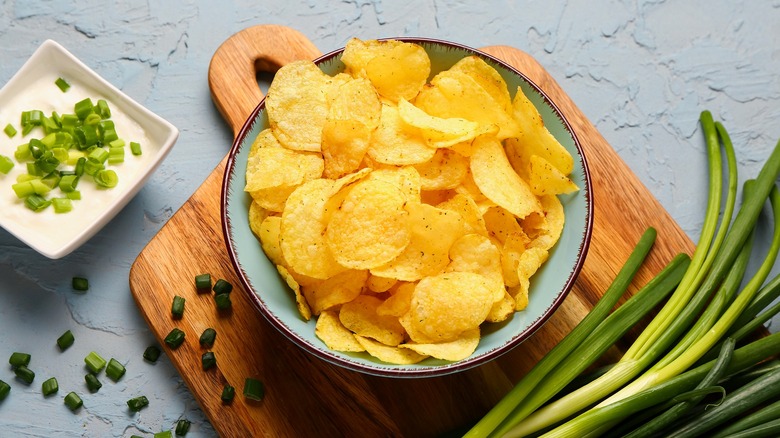Ditch The Chips And Deep-Fry Potato Cups For Maximum Dipping Power
Every now and then, you'll come across a dip so good that chips simply don't do it justice. They're just too flat to get a decent amount on them. While potato skins do a better job at scooping up more dip, they don't have the same satisfying crunch that chips do. It turns out that the best medium for gorging yourself on excellent dip is deep-fried potato cups, a crispy, golden vessel that graces your taste buds with the optimal potato-to-dip ratio.
Daniel Gritzer's recipe for deep-fried potato cups involves slicing potatoes in half along their shorter axis, rather than the longer one you'd typically slice along for a baked potato. After baking it to your desired tenderness, you'll then need to scoop out enough flesh from the center to end up with a shape similar to a teacup — with enough flesh left over to hold the cups together. From there, it's all about deep-frying them until golden brown, just like you would french fries.
Deep-fried potato cups go well with any dip you'd eat with chips, but they're especially great with the chunkier kinds like a spicy, creamy buffalo chicken dip. Costco's iconic crab dip is another fantastic option, and adding a spot of cream cheese turns the cups into fuller-bodied crab rangoons. If you're feeling minimalist, you can also skip the dip and liven up the cups with a squeeze of lemon and some salt — they're that good of a base.
Using potato slurry makes everything crispier and tastier
Gritzer's recipe also calls for coating the potato cups in a slurry made from the scooped-out flesh to make them even crispier. To make it, blend the flesh with just enough water to achieve a slightly pasty consistency. Coating the cups in a thin layer of this before frying gives you a tantalizingly crunchy crust.
It's an ingenious technique that works on several levels. The thin coat of slurry is effectively an additional layer of hydrated starch. When it's fried, the water inside the starch evaporates, leaving behind the porous, semi-rigid crust that gives the potato cups their crunch. Without the slurry, the cups have less starch and water to work with, so they won't develop the same amount of crispness. The coating also makes the surface of your potatoes a little bit rougher, increasing the points of contact with the frying oil and crisping things up even further.
At the same time, you'll get more of the Maillard reaction going because of that rougher texture, making the potato cups taste richer and nuttier. Using actual potato flesh to make the slurry also ensures that you're maximizing the potato flavor of your cups. Other starches like flour and cornstarch can dilute that flavor. While they may be just as effective in crisping up the cups, they can also make them taste slightly less potatoey. Any leftover potato flesh can be turned into loaded mashed potato balls for a bonus snack.

